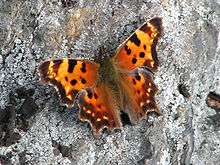Polygonia comma
| Eastern comma | |
|---|---|
 | |
| Scientific classification | |
| Kingdom: | Animalia |
| Phylum: | Arthropoda |
| Class: | Insecta |
| Order: | Lepidoptera |
| Family: | Nymphalidae |
| Tribe: | Nymphalini |
| Genus: | Polygonia |
| Species: | P. comma |
| Binomial name | |
| Polygonia comma (Harris, 1842) | |
| | |
| Range map showing distribution of the Eastern comma. | |
| Synonyms | |
|
Nymphalis comma | |
Polygonia comma (eastern comma) is a North American butterfly in the family Nymphalidae, subfamily Nymphalinae.
Description

This butterfly is seasonally variable. The upper side of the summer forms hind wings are all black, whereas the winter forms hind wings are reddish-orange. The underside of both forms is striped with dark and light brown. There is a silvery comma mark in the middle of the hindwing in both forms. Its wingspan is 4.5–6.4 cm (1.8–2.5 in).
Habitat
The Eastern comma may be spotted in woods near rivers, ponds, marshes, swamps, and other water sources.
Nectar plants
This butterfly seldom visits flowers, but rather feeds on sap, rotting fruit, salts and minerals from puddling, and dung.
Host plants
False nettle (Boehmeria cylindrica), hops (Humulus), wood nettle (Laportea canadensis) American elm (Ulmus americana), and nettle (Urtica).
Life cycle
The green eggs are laid singly or in stacks under host plants leaves and stems. The spiny larva varies in color from pale green to yellow to white and to even black. The solitary larva feeds on leaves at night. Older larvae construct daytime leaf shelters by pulling a single leaf together with silk. The chrysalis is brown and covered with spines. Winter form adults overwinter;[1] some will also migrate south for the winter.
Similar species
The dark form of comma is frequently confused with the dark form of the question mark (P. interrogationis), but the two can readily be distinguished by the shape of the comma mark on the underside. The pale form is easily confused with the satyr comma (P. satyrus), which usually occurs north and west of the eastern comma's range. They can be distinguished by the upperside colour, which is orange brown in comma and tawny yellowish brown in satyrus; by the underside pattern, which tends to be mottled in comma but appears to be more longitudinally streaked in P. satyrus; and by the row of pale submarginal spots on the hindwing upperside, which tend to be separate and surrounded by dark shading in comma, but are larger and tend to run together into a pale band in P. satyrus.
References
- Eastern Comma, Butterflies of Canada
| Wikimedia Commons has media related to Polygonia comma. |
| Wikispecies has information related to: Polygonia comma |
- ↑ Scott, J. A. (1999). Hibernal diapause of North American Papilionoidea and Hesperioidea. Journal of Research on the Lepidoptera 18(3):171-200.
External links
| Wikimedia Commons has media related to Polygonia comma. |
| Wikispecies has information related to: Polygonia comma |
- Eastern comma on the UF / IFAS Featured Creatures Web site